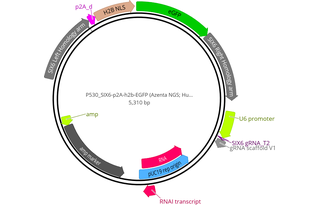P530_SIX6-p2A-h2b-EGFP
(Plasmid
#239101)
-
PurposeHuman donor plasmid for integration of p2A-h2b-EGFP into the 3' end of SIX6. This includes the donor casette and a U6 driven guide sequence to be used with Cas9.
-
Depositing Lab
-
Sequence Information
Ordering
| Item | Catalog # | Description | Quantity | Price (USD) | |
|---|---|---|---|---|---|
| Plasmid | 239101 | Standard format: Plasmid sent in bacteria as agar stab | 1 | $89 | |
Backbone
-
Vector backbonepUC19
- Total vector size (bp) 5310
-
Vector typeMammalian Expression ; Donor plasmid
Growth in Bacteria
-
Bacterial Resistance(s)Ampicillin, 100 μg/mL
-
Growth Temperature37°C
-
Growth Strain(s)NEB Stable
-
Copy numberHigh Copy
Gene/Insert
-
Gene/Insert nameSIX6
-
SpeciesH. sapiens (human)
-
Entrez GeneSIX6 (a.k.a. MCOPCT2, ODRMD, OPTX2, Six9)
- Promoter Endogenous SIX6 promoter
-
Tag
/ Fusion Protein
- p2A-h2b-EGFP (C terminal on insert)
Cloning Information
- Cloning method Gibson Cloning
- 5′ sequencing primer GAGTAGTGCGCGAGCAAAAT
- 3′ sequencing primer GAGTCAGTGAGCGAGGAAGC
- (Common Sequencing Primers)
Resource Information
-
Supplemental Documents
Terms and Licenses
-
Academic/Nonprofit Terms
-
Industry Terms
- Not Available to Industry
Trademarks:
- Zeocin® is an InvivoGen trademark.
These plasmids were created by your colleagues. Please acknowledge the Principal Investigator, cite the article in which the plasmids were described, and include Addgene in the Materials and Methods of your future publications.
-
For your Materials & Methods section:
P530_SIX6-p2A-h2b-EGFP was a gift from Karl Wahlin (Addgene plasmid # 239101 ; http://n2t.net/addgene:239101 ; RRID:Addgene_239101) -
For your References section:
CRISPR Generated SIX6 and POU4F2 Reporters Allow Identification of Brain and Optic Transcriptional Differences in Human PSC-Derived Organoids. Wahlin KJ, Cheng J, Jurlina SL, Jones MK, Dash NR, Ogata A, Kibria N, Ray S, Eldred KC, Kim C, Heng JS, Phillips J, Johnston RJ Jr, Gamm DM, Berlinicke C, Zack DJ. Front Cell Dev Biol. 2021 Nov 16;9:764725. doi: 10.3389/fcell.2021.764725. eCollection 2021. 10.3389/fcell.2021.764725 PubMed 34869356







